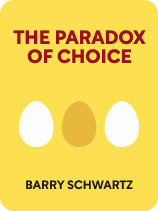

This article is an excerpt from the Shortform book guide to "The Paradox of Choice" by Barry Schwartz. Shortform has the world's best summaries and analyses of books you should be reading.
Like this article? Sign up for a free trial here .
What is second-order thinking? How can you use second-order thinking to prioritize decision-making?
Second-order thinking is a process that you can use to make better and more deliberate decisions. During second-order thinking, you think about the consequences of your choices in order to make more informed decisions. There are four categories of second-order decisions: rules, presumptions, standards, and routines.
Continue reading to learn more about each type of second-order decision.
How to Prioritize Decisions
In addition to narrowing our freedom of choice by engaging in close relationships, Schwartz recommends deciding which choices to spend time on, and which to make without much deliberation.
Schwartz cites the work of Cass Sunstein and Edna Ullmann-Margalit, who described decisions we shouldn’t have to think carefully about, and can therefore automate, as second-order decisions, or second-order thinking. They identify four categories of second-order decisions: rules, presumptions, standards, and routines. Incorporating each into your life can reduce stress by limiting the number of decisions you need to make.
| Second-Order Decisions and the Legal System Schwartz focuses on individualized second-order decisions, like sticking to a morning routine. However, second-order (automated) decisions may also encompass higher-stakes decisions, such as those involving the legal system. In a 1999 paper, Sunstein and Ullmann-Margalit wrote that institutions and the legal system use second-order decisions as often as average people do. As examples, Sunstein and Ullmann-Margalit cited legal authorities enforcing speed limit laws (which fall under rules), or government agencies setting limits on energy use for corporations, which can be appealed if necessary (an example of presumptions). Schwartz’s view on second-order decisions is more casual and low-stakes, since he’s only discussing them in terms of individuals. However, it is important to note that all decisions have consequences, and you should be able to revisit and reconsider second-order decisions if you think they could have a negative impact. |
Rules
Sunstein and Ullmann-Margalit’s first category of second-order decisions is rules. By making rules for ourselves about certain choices, we can alleviate the burden of many choices in our lives.
For example, we all technically have the choice of whether or not to stop at a stop sign. Most people, though, make a rule for themselves to always stop. This makes the decision automatic so they don’t need to think about it.
The law makes this an easy rule to follow, but there are many non-legal scenarios for creating your own rules, as well. For example, you could make a rule to always call your mother on Mother’s Day, or to never break a promise made to a friend. Rules like these can significantly help in social relationships, as well as limiting the time you spend making choices.
| Strategies for Setting Rules Some rules can be decided without much thought at all, like making a rule to follow the law. However, it can be difficult to determine what other choices you should make rules for. Psychology Today lists several types of decisions that are helpful to set rules for. If there’s a product you use frequently, or often run out of, set a rule to always buy it when you see it in a store.Set a rule to never skimp when you need something—for example, always fill your tank with gas if you need it.When you have a routine, set a rule to always do it the same way. For example, if you already replace your toothbrush several times a year, you could set a rule to buy a new toothbrush every three months. |
Presumptions
The second category of second-order decisions is presumptions. Sunstein and Ullmann-Margalit assert that, like rules, presumptions are predetermined choices you make for yourself. However, you can easily change presumptions if necessary.
For example, if you start work five days a week at 9:00 a.m., you might set your alarm for 7:00 a.m. throughout the workweek. Your presumption is to wake up at 7:00 each day, so you have one less decision to make. However, if you have an 8:00 a.m. doctor’s appointment one day, you might set your alarm for earlier. The change of circumstance prompted you to change your presumption.
| Presumptions and Writing We all use presumptions in our daily lives, but they’re especially applicable to certain areas. When you write, for example, you use a multitude of presumptions, with many reasons to occasionally break them. This is true whether you’re writing an email to your boss, a letter to a friend, or a 400-page novel. Many grammar rules are presumptions: Starting a sentence with “and,” for example, is technically incorrect, but there are situations where it’s reasonable and effective. Presumptions are general guidelines to follow, but we allow room for flexibility when those guidelines don’t fit. |
Standards
The third category of second-order decisions is standards. Sunstein and Ullmann-Margalit write that standards are more flexible than rules or presumptions, but they still confine your choices. To set standards means to sort your options into two categories: acceptable and unacceptable.
An example is choosing from a menu at a restaurant you’ve never been to before. You don’t have a usual order here yet, but you know the foods you like and the foods you don’t. Your choices, then, might look something like this: You like salads and sandwiches, so you consider those as options, but you don’t like soups or fried foods, so you bypass those options. You still need to make a decision, but you save yourself time and effort by knowing how to automatically narrow your choices.
Standards also help us build relationships. If you decide to start dating, for instance, you’ll probably have in mind certain qualities you want in a partner and certain qualities you don’t. You still might have to meet many new people, but standards make it easier to decide whom you want to spend time with.
Standards dovetail with the concept of satisficing: When you make choices based on what meets your standards rather than searching for the best possible option, you make decisions easier for yourself while still finding satisfying options.
| How Expanded Choice Can Affect Our Standards Setting standards is an effective technique to limit your choices, but be aware that expanded choice can inadvertently affect how you set standards. Studies on how people use dating apps found that, when presented with a large number of options, people tend to set their standards for potential matches higher and reject many people. This is in line with the tendency to maximize in a society of expanded choice. Consciously setting standards can help you avoid this, because you automatically eliminate any option below your standards. |
Routines
Sunstein and Ullmann-Margalit’s final category of second-order decisions is routines. We build routines when we find something that meets our standards.
To use the previous restaurant example, if you order a chicken Caesar salad and like it, you might order it every time you go to that restaurant. Because you’ve made a satisfactory and repeatable decision, you don’t have to spend time thinking about what to order again (you have a routine). Likewise, if you’ve been dating and find a person you like, you might start seeing them every Saturday night. There will likely be more choices ahead about the relationship, but for now, you’ve found a healthy routine and eliminated the need to decide what to do and with whom each Saturday night.
We have routines for spending time with friends and family, too—we don’t choose whether or not to continue the relationship every time we see them. Relationships would be close to impossible without routines.
| Forming Routines In Atomic Habits, James Clear provides advice for forming new routines, which he defines as a repeated series of habits—for example, flossing, brushing your teeth, and using mouthwash every night. Clear focuses on the habits and routines that we repeat over the course of our lives, and how to develop positive new habits and routines and phase out unhelpful ones. Clear recommends listing the different habits you repeat over the course of a day and classifying which are positive, negative, or neutral. To form new habits, he recommends planning them in advance at first to ensure you carry them out and associating new behaviors with pre-existing habits to integrate the new ones into your life. Since our routines are made up of habits, taking these steps can form new routines. For example, if you decide to make tea instead of coffee every morning, drinking tea will become part of a daily routine. |

———End of Preview———
Like what you just read? Read the rest of the world's best book summary and analysis of Barry Schwartz's "The Paradox of Choice" at Shortform .
Here's what you'll find in our full The Paradox of Choice summary :
- Why the more choices we have, the more stressed and indecisive we feel
- How to better navigate our choices, from groceries to health insurance
- Whether it's better to seek the best or accept "good enough"






